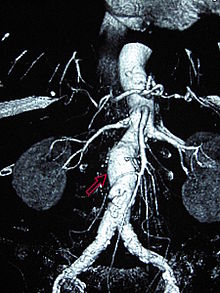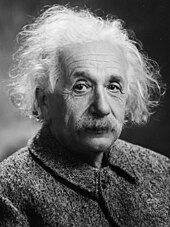用戶:Dahesor/沙盒
| 沙 放置在 「<<<」 和 「>>>」 內的為專有名詞,正在為其尋找正確的翻譯。 |
| Rudolph Nissen | |
|---|---|
| 出生 | September 5, 1896 Neisse, German Empire |
| 逝世 | 1981年1月22日(84歲) Riehen, Switzerland |
| 知名於 | Nissen fundoplication |
| 科學生涯 | |
| 研究領域 | General surgery |
| 受影響自 | Ferdinand Sauerbruch |
| 簽名 | |
 | |
魯道夫·尼森(1896/9/5 — 1981/1/22)是一名傑出的外科醫生,在土耳其,美國和瑞士擔任外科部門的主席。他以尼森胃底摺疊術(一種治療胃食管反流的手術方法)的名字命名。在1931年,尼森完成了第一例肺切除術。1948年,他進行了一次腹部手術,將愛因斯坦的壽命延長了幾年。
生平
[編輯]尼森於1896年出生在,德國西里西亞的一個猶太德國家庭中。他是著名外科醫生弗朗茲·尼森(Franz Nissen)的兒子。魯道夫·尼森先在慕尼黑和馬爾堡從事醫學研究。然後,他在弗萊堡大學名醫卡爾·阿爾伯特·尤金·阿紹夫的指導下接受病理學訓練。在第一次世界大戰期間,他在一個醫療隊服役,但肺部不幸受槍擊而重傷,導致了他肺部終生的問題。1921年,他作為德國外科醫生費迪南德·索爾布魯赫的助手來到慕尼黑大學。六年後,索爾布魯赫和尼森移居到柏林大學。尼森於1939年離開土耳其前往美國。他在麻省總醫院擔任了兩年的外科手術研究員又在紐約的猶太醫院和<<<Maimonides醫療中心>>>擔任外科手術計劃的主席的位置待了幾年。從1952年到1967年退休,他一直是巴塞爾大學的系主任。1981年,他在<<<Riehen>>>不幸逝世。[1]
Surgical contributions
[編輯]Nissen fundoplication
[編輯]
While in Istanbul in 1936, Nissen excised an esophageal ulcer from a 28-year-old patient. The operation required Nissen to remove a portion of the lower esophagus and join the remaining esophagus to the stomach. In an effort to avoid the backflow of stomach contents into the patient's esophagus, Nissen wrapped (plicated) folds of the patient's upper stomach around the lower esophagus. Following the patient subsequently, Nissen noted that the patient's problems with heartburn improved after surgery.
Through the 1940s and 1950s, Nissen treated many patients with hiatal hernias using conventional methods developed by other surgeons. He even performed one of these procedures, an anterior gastropexy, on eminent radiologist Gustav Bucky. Bucky was very ill when he presented to Nissen, but he completely recovered. Though Bucky remained asymptomatic for at least 15 years, many patients experienced relapses. By 1955, Nissen began to think back on the successful procedure in Istanbul. Now based in Basel, he operated on two patients with reflux esophagitis, wrapping a portion of the stomach around the lower esophagus. He published the results of the two cases in 1956.
Pneumonectomy
[編輯]
By training under Sauerbruch, Nissen developed unique skill in surgery of the chest. Through his own mentoring by Polish-Austrian surgeon Jan Mikulicz-Radecki, Sauerbruch had learned to perform thoracic surgery by use of a pressure chamber before it was possible to give anesthesia to patients through breathing tubes.[2]
In 1931, Nissen treated a 12-year-old girl who had sustained a crush injury to the chest with chronic pus production from the left lung. Nissen elected to perform left pneumonectomy, or removal of the lung. The first surgery was halted when the patient experienced asystole ("flatline"). The patient was stabilized and the second phase of the pneumonectomy was completed two weeks later. The patient survived for several years. Nissen was the first Western physician to complete the procedure; successful pneumonectomy was reported in the United States in 1933.[3]
Einstein's aneurysm repair
[編輯]
In December 1948, Nissen admitted Albert Einstein to Jewish Hospital for removal of intestinal cysts. However, the scientist was also suffering from an abdominal aortic aneurysm (AAA).[4] An aneurysm is a dilatation that occurs in a blood vessel. In the portion of the aorta that runs through the abdomen, aneurysms are typically asymptomatic until rupture is imminent.[5] AAA rupture can cause immediate death from exsanguination.[6] Definitive surgical treatment for AAA had not been devised in the 1940s. Beginning in 1943, reinforcement with cellophane had been used to induce fibrosis in the vessel, decreasing the risk of rupture. Nissen wrapped the aneurysm with cellophane and Einstein recovered from the surgery.[4]
Upon his hospital discharge, Einstein was surrounded by photographers and he was photographed with his tongue sticking out at them. He sent an autographed newspaper clipping of the photo to Nissen with the inscription "To Nissen my tummy / The world my tongue."[7] Einstein lived for several years after Nissen wrapped his AAA in cellophane.[4] Einstein died in a Princeton, New Jersey hospital in 1955. Initial news reports listed gallbladder inflammation as the cause of death.[8] However, his medical team had suspected gallbladder irritation resulting from a leaking AAA.[9] An autopsy conducted by pathologist Thomas Harvey showed that he died of a leaking AAA.[10]
By the time of Einstein's death, surgical AAA repair was technically possible but still very uncertain.[11] The surgeon who saw Einstein in Princeton, Frank Glenn of New York Hospital, proposed surgery. Einstein was in his seventies and he elected to die peacefully rather than undergo surgery.[4] "I want to go when I want," Einstein told his physicians.[12] He told his secretary Helen Dukas, "I can die without the help of the doctors."[12] He also told her that it was "tasteless to prolong life artificially. I have done my share. It is time to go. I will do it elegantly."[11]
Legacy
[編輯]The Rudolf Nissen Prize is awarded by the Deutsche Gesellschaft für Allgemein- und Viszeralchirurgie (German Society of General and Visceral Surgery) to recognize surgeons who have advanced the field of gastroenterological surgery.[13]
References
[編輯]- ^ Schein, Moshe, Schein, Heidi and Wise, Leslie. Rudolf Nissen: The man behind the fundoplication. Surgery. 1999, 125 (3): 347 [August 10, 2013]. doi:10.1016/s0039-6060(99)70248-5.
- ^ Granderath, Frank, Kamolz, Thomas, and Pointer, Rudolph. Gastroesophageal Reflux Disease: Principles of Disease, Diagnosis, and Treatment. Springer. 2006: 163. ISBN 3211323171.
- ^ Classics in Thoracic Surgery: Total pneumonectomy. Rudolf Nissen, M.D. (abstract). Annals of Thoracic Surgery. 1980, 29 (4): 390–394. PMID 6987966. doi:10.1016/s0003-4975(10)61496-8.
- ^ 4.0 4.1 4.2 4.3 Lesney, Mark. Einstein's Aneurysm: Of Cellophane and Rudolph Nissen. Vascular Specialist. January 24, 2012 [August 10, 2013]. (原始內容存檔於March 14, 2016).
- ^ Bope, Edward, Kellerman, Rick. Conn's Current Therapy 2013. Elsevier. 2012: 413–414. ISBN 1455733342.
- ^ Brooks, Adam, Cotton, Bryan, Tai, Nigel and Mahoney, Peter. Emergency Surgery. John Wiley & Sons. 2010: 101–102. ISBN 1444315188.
- ^ Abraham, Carolyn. My dad has Einstein's brain. The Guardian. April 7, 2004 [August 10, 2013].
- ^ Prof. Einstein dead; Eisenhower leads nation in mourning. Jewish Telegraphic Agency. April 19, 1955 [September 6, 2013].
- ^ Apple, R. W. Ruptured artery lethal. Daily Princetonian. April 19, 1955 [September 6, 2013].[永久失效連結]
- ^ Einstein waited too long, lost 50-50 chance to live. Toledo Blade. July 12, 1955 [September 6, 2013].
- ^ 11.0 11.1 Isaacson, Walter. Einstein: His Life and Universe. Simon & Schuster. 2007: 542. ISBN 1416539328.
- ^ 12.0 12.1 Highfield, Roger and Paul Carter. The Private Lives of Albert Einstein. Macmillan. 1994: 262. ISBN 0312302274.
- ^ Prizes Awarded by the DGAV. Deutsche Gesellschaft für Allgemein- und Viszeralchirurgie. [August 10, 2013].
